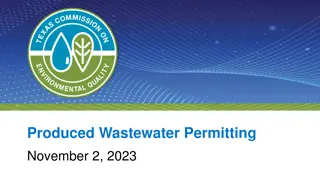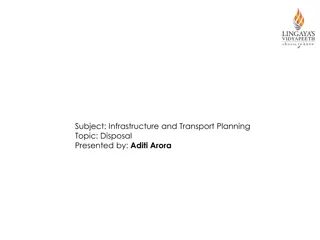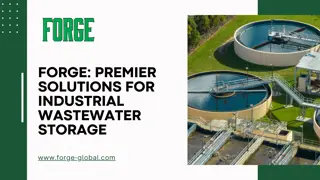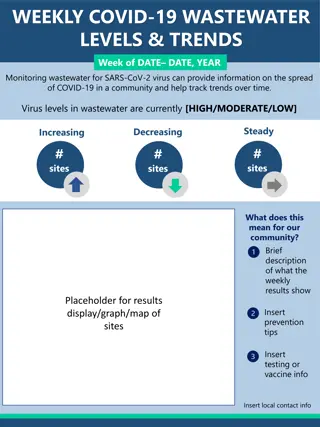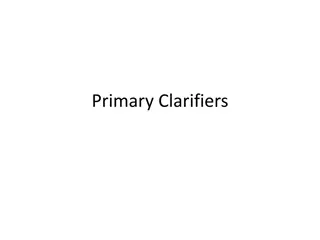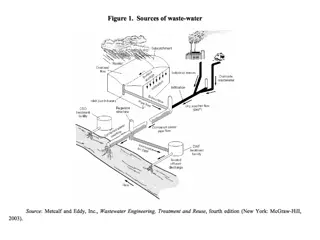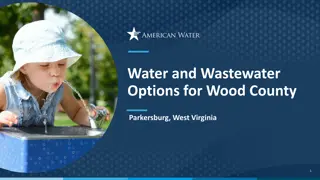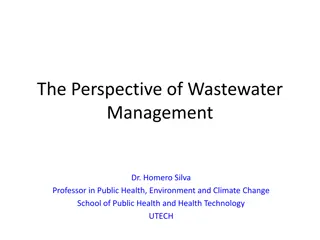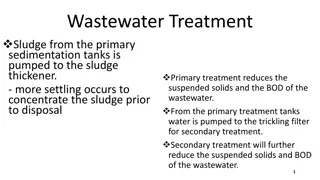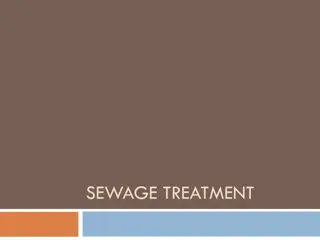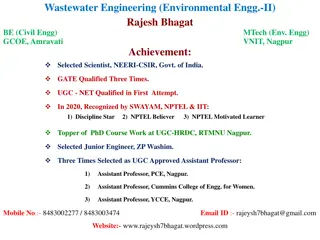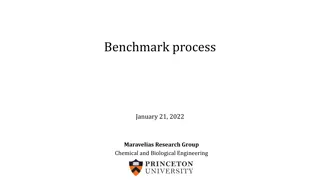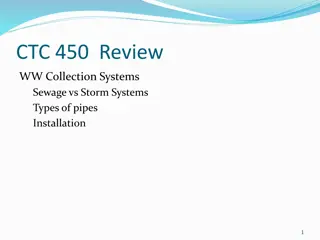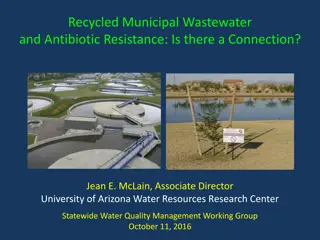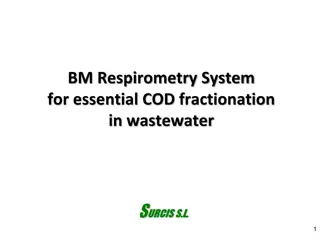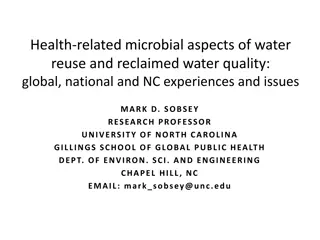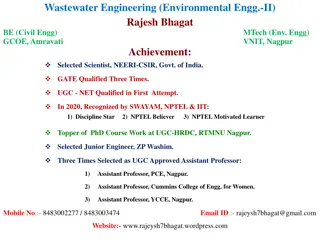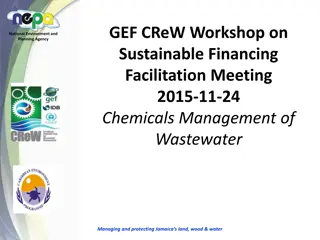Advanced Wastewater Treatment Solutions for Any Requirement
Enpure offers an innovative collection of wastewater treatment options, including Enpure Pro and Enpure Container, designed for easy retrofit, fast delivery, and minimal site disruption. The Enpure process flow involves primary treatment and flow equalization followed by aerobic biological treatment with biomass growth. A key feature is the low sludge production, thanks to the use of fixed-film media. The process ensures efficient removal of solids and organic matter, resulting in clear and odorless effluent suitable for various applications. Enpure solutions are ideal for remote sites, sensitive aesthetics, and locations with limited space.
- Wastewater treatment
- Enpure solutions
- Advanced technology
- Biological treatment
- Sustainable practices
Download Presentation

Please find below an Image/Link to download the presentation.
The content on the website is provided AS IS for your information and personal use only. It may not be sold, licensed, or shared on other websites without obtaining consent from the author. Download presentation by click this link. If you encounter any issues during the download, it is possible that the publisher has removed the file from their server.
E N D
Presentation Transcript
APPLICATION: 100PE TO 10,000PE 1
WASTEWATER TREATMENT OPTIONS TO SUITE ANY REQUIREMENT 2
ENPURE COLLECTION ENPURE UG ENPURE PRO ENPURE CONTAINER EASIEST RETROFIT OPTION LOW PROFILE MOBILE FASTEST DELIVERY & PROJECT TURNAROUND SPACE SAVING EXTREMELY ROBUST CONSTRUCTION LEAST DISRUPTION TO SITE EASILY HIDDEN EXCELLENT LOGISTICS LEAST AMOUNT OF CIVIL WORKS SURFACE CAN BE USED FOR OTHER ACTIVITIES E.G. PARKING, GREEN SPACE, EVEN BUILDINGS RENTAL & LEASE HIRE OPTIONS LEAST AMOUNT OF CONCRETE IDEAL FOR OIL & GAS EXPLORATION IDEAL FOR SITES WITH EXISTING SEPTIC/CONSERVANCY TANKS IDEAL FOR MILITARY IDEAL FOR NEW SITES 3 IDEAL FOR REMOTE SITES IDEAL FOR SITES WITH SENSITIVE AESTHETICS IDEAL FOR REMOTE LOCATIONS
ENPURE PROCESS FLOW STEP 1: PRIMARY TREATMENT & FLOW EQUALISATION Primary Treatment is all about separating solids from the wastewater. This entails trapping large solids & settling fine solids. For best result a minimum of 24hr retention is desired. down over time through anaerobic biological processes If Primary Treatment is too small the Solids & Sludge will buildup too fast! Enough storage volume is required to allow Organic Solids & Sludge to be broken The sewage is gravity fed into the 1st chamber of the Primary Treatment Tank. The buffer chamber equalizes the peak flows and regulates the amount of effluent that is fed into the Bioreactors. Effective Primary Treatment can reduce BOD by up to 40% and TSS by up to 80% Inside the tank, the solids sink to the bottom while the grease and fats float to the top. 1st Chamber Primary Treatment 2nd Chamber Primary Treatment Buffer Chamber Wastewater is fed to the Bioreactor Chambers for biological treatment. The plant runs at the maximum efficiency when the hourly feed rate is spread out over 24hrs Primary Treated wastewater moves across and into the Buffer Chamber. Primary Treatment stage creates an anaerobic treatment environment where the organic solids are broken down & digested. 4
ENPURE PROCESS FLOW STEP 2: AEROBIC BIOLOGICAL TREATMENT BIOMASS GROWTH NEW MEDIA BIOMASS GROWTH One of the KEY BENEFITS of Fixed-Film Media is that the Waste Sludge Production is very low. This means the volume of waste sludge sent to Primary Treatment is little. What little sludge sent back and stored in Primary Treatment is usually digested by anaerobic process. Therefore no Buildup of Sludge to be removed by exhausters! FINE BUBBLE AERATION Inside the Bioreactors, an enormous population of specialized bacteria grow on the fixed film media. The organisms survive by feeding on the nutrients present in the wastewater, as well as oxygen introduced by aeration. Population The effluent then passes into the Clarifier where the sludge settles at the bottom and the clear water separates at the top. Aeration is required to: Provide Oxygen to the Bacteria To circulate the water bringing food (waste) & Oxygen into contact with the bacteria growing on the Fixed-Film Media High Surface Area Huge Bacteria The Bubbles scour the Fixed-Film Media brushing off excess Biomass. This keeps the Biofilm thickness on the Fixed-Film Media in check Anti-Clog Design Easy to clean if needed Extremely Robust 15 Year Warrantee! GTB Positive displacement Aeration Blower Heavy duty & durable Low Noise & vibration Efficient Low power costs Replaceable motor Pressure protection Efficient Oxygen Saturation Reduces Size of Aeration Blower Reduces Operating Cost The final product is a clear & odourless effluent ready for discharge to the environment or water reuse applications such as irrigation 3 Stage Bioreactos Storage Tank Clarifier The accumulated sludge at the bottom of the clarifier is recycled back to the Primary Treatment tank and the clear water enters the storage tank. 5 FIXED FILM MEDIA
WASTEWATER TREATMENT TO SUITE YOUR BUDGET 6
VERSATILITY & ECONOMY SBR BENEFITS SBR RETROFITS SIMPLE RETROFIT OPTION ECONOMIC PRICE POINT POTENTIAL TO RETROFIT TO EXISTING SEPTIC/CONSERVANCY TANKS LOW PROFILE/EASILY HIDDEN IDEAL FOR SITES WITH SENSITIVE AESTHETICS FASTEST DELIVERY & PROJECT TURNAROUND SPACE SAVING LEAST DISRUPTION TO SITE SURFACE CAN BE USED FOR OTHER ACTIVITIES E.G. PARKING, GREEN SPACE, EVEN BUILDINGS POTENTIAL FOR NO CIVIL WORKS REQUIRMENT EQUIPMENT MAKES UP SMALL PACKAGES FOR SHIPPING. SAVING COST AND COMPLICATION ENTRIE PROCESS RUN IN A SINGLE SBR REACTOR TANK, INCLUDING DE- NITRIFICATION
SBR MAX PROCESS FLOW If Primary Treatment is too small the Solids & Sludge will buildup too fast! Enough storage volume is required to allow Organic Solids & Sludge to be broken down over time through anaerobic biological processes Primary Treatment is all about separating solids from the wastewater. This entails trapping large solids & settling fine solids. For best result a minimum of 24hr retention is desired. The sewage is gravity fed into the 1st chamber of the Primary Treatment Tank. Wastewater is fed to the SBR Reactor Tank for Aerobic Biological Treatment. The SBR Process involves a cycle of activities which are typically repeated 4 x a day AERATION SETTLING DISCHARGE CLEAR WATER Effective Primary Treatment can reduce BOD by up to 40% and TSS by up to 80% 2nd Chamber Primary Treatment 1st Chamber Primary Treatment Inside the tank, the solids sink to the bottom while the grease and fats float to the top. ATTENTION: The Aeration actually consists of two steps: 1. Longer Periods to remove Organics & Nutrients (commonly measured as BOD & COD). Also during the Longer periods Nitrification takes place. 2. The Clear Water is Discharged out, usually to a contact storage tank for Sterilization. The Treated Water is fit to release to the Environment, or for reuse such as irrigation During Aeration the enormous population of bacteria (Activated Sludge) is mixed with the recently added wastewater. The Bacteria consume the waste and oxygen provided. After Aeration the SBR Reactor is left still for at least an hour. The Activated Sludge settles very well and leaves behind a clear layer of water Primary Treatment stage creates an anaerobic treatment environment where the organic solids are broken down & digested. flows conditions for De-nitrification. De-nitrification removes Nitrate, and the process occurs under Anoxic conditions (low oxygen just before septic conditions). The intermittent Aeration is actually for mixing rather than providing oxygen. The 2nd Chamber also acts as a buffer chamber to equalizes the peak Intermittent Aeration, usually just after fresh wastewater has been fed to the SBR Reactor. The Wastewater high in Carbon allows 8
SBR PROCESS CYCLE STEP 2: AERATION STEP 3: SETTLING STEP 4: CLEARWATER DISCHARGE STEP 1: FEED Gravity Feed from 1st Primary Treatment Tank AND SO THE NEXT CYCLE STARTS ETC TREATED WATER Discharge Pump Feed Pump 2nd Chamber Primary Treatment / Buffer tank SBR Reactor 9
COMPARISONS DTF ENPURA Investment Cost 8,400,000/= 14,000,000/= Capacity 23m3/dy 75m3/dy Capital Investment/m3 Kshs. 365,217/m3 Kshs. 186,666/m3 Land Suitability Slope required No slope required Sludge Black sludge, septic until dried Brown sludge, non septic 10



